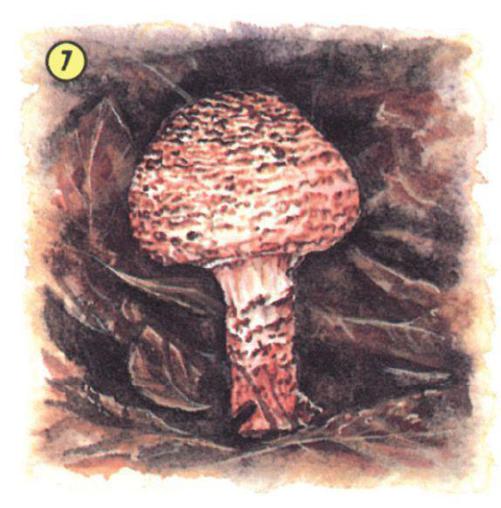SAS Urban Survival Handbook (51 page)
Read SAS Urban Survival Handbook Online
Authors: John Wiseman
Tags: #Health & Fitness, #Reference, #Survival, #Fiction, #Safety, #Self-Help, #Personal & Practical Guides, #General, #Survival Skills

3▶Fool’s parsley
(Lesser hemlock)
Aethusa cynapium
Native to the British Isles and a common weed. Annual with parsley-like leaves and white flowers in umbrella-like heads, followed by egg-shaped fruits. Height: 60-120 cm (24-47 in).
All parts are poisonous. May be FATAL.
4▶Cowbane
Cicuta virosa
Native to northern and central Europe, and Asia eastwards to Japan, in ditches, marshes and shallow water. Perennial with umbrella-like heads of white flowers. Height: 30-120 cm (12-47 in).
All parts are poisonous. May be FATAL.
5▶Hemlock
(Poison hemlock/California fern)
Conium maculatum
Native to Europe, Asia and North Africa. It has been introduced to North America, the West Indies, South America and New Zealand. A weed of damp places and woods. Biennial with umbrella-like heads of white flowers. Height: 1.5-2.1 m (5-7 ft).
All parts are poisonous. May be FATAL.
It is dangerous for children to use the hollow stems as peashooters.
6▶Water dropwort
Oenanthe crocata
Native to the British Isles, France, Spain, Portugal, Italy, Sardinia and Morocco. Found in moist places. Perennial with parsley-scented and parsley-like leaves and umbrella-like heads of white flowers. Height: 60-150 cm (24-59 in).
All parts are poisonous. May be FATAL.
7▶Giant hogweed
Heracleum mantegazzianum
Native to the southeastern USSR and introduced into many countries. Found on wasteland and in moist areas, and as an ornamental. Giant biennial with parsley-like leaves and umbrella-like heads of white flowers. Height: 3-3.6 m (10-12 ft).
All parts are poisonous, even by skin contact.
NETTLE FAMILY
Urticaceae
Poisons causing numbness, tingling in the mouth, abdominal pains, vertigo, vomiting, purging, delirium, paralysis and affecting the heart.
8▶Wood Nettle
(Devil nettle/Fever nettle)
Laportea canadensis
Native to eastern US. A tropical shrub with large oval leaves. Height: 120-180 cm (47-71 in).
The whole plant is covered with small, irritant hairs. Leaves are poisonous.
ZAMIA FAMILY
Zamiaceae
Irritant poisons, causing burning pains in the throat and stomach, thirst, nausea, vomiting, fatigue and shock.
9▶Coontie
(Comptie/Seminole bread)
Zamia floridana
Native to Florida and the West Indies, a very common tropical ornamental and a houseplant. Palm-like plant with pinnae (leaves) to 15 cm (6 in) long. It has a short, tuber-like trunk. Height: 60-90 cm (24-35 in).
Poisonous tuber.

 POISONOUS FUNGI
POISONOUS FUNGI


Most fungi are associated with trees or decaying wood. The mushrooms or toadstool-like form we see is only the fruiting body – a large part of the fungus consisting of fine threads, the mycelium, spreading underground.
Here are some of the more poisonous types in Europe, the US and Australia – they are NOT the only ones. Fungi from some areas are not well documented. The toxicity of even Australian species, for example, has not been extensively investigated.
Eat ONLY fungi that you can positively identify as SAFE. Some poisonous kinds look very like edible ones – DON’T GUESS.
ALWAYS avoid small or large brown mushrooms, especially if the gills below the cap are purple-brown or pink. Discourage children from eating or touching any fungi found growing in the city.
1▶Death cap
Amanita phalloides
Usually found under birch, beech, conifers or dogwood in autumn. The stem is paler than the cap, with a bag-like volva at base (only visible when fungus is dug up). Cap diameter: 6.5-15 cm (2 1/2-6 in).
Symptoms: stomach pain, vomiting, diarrhoea (after 8-14 hours). After 2 days: deep coma and jaundice. DEADLY.
2▶Fly agaric
Amanita muscaria
Typically grows in clusters under pine or birch in autumn. Older specimens are very pale with loose white flecks. Cap diameter: 5-25 cm (2-10 in).
VERY POISONOUS. Symptoms: delirium, vomiting and coma.
3▶Destroying angel
Amanita virosa
Found in mixed woods and grass, with bag-like volva and shaggy stem. Smells sweet and sickly. Cap diameter: 5-12 cm (2-5 in).
DEADLY. Symptoms as death cap.
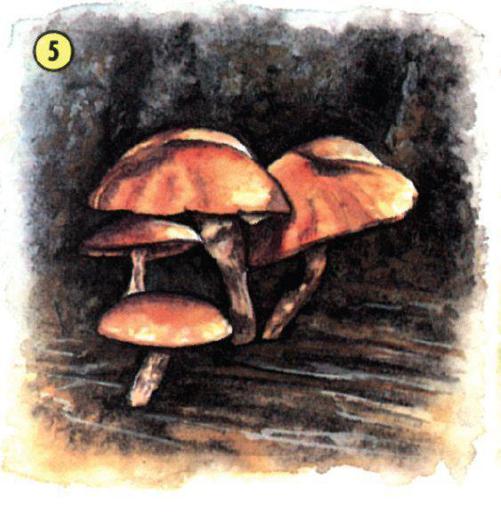
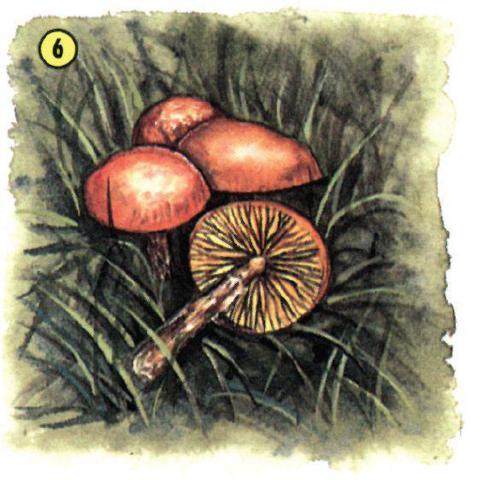
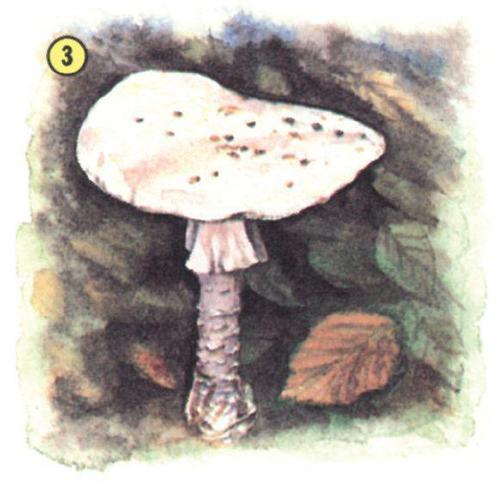
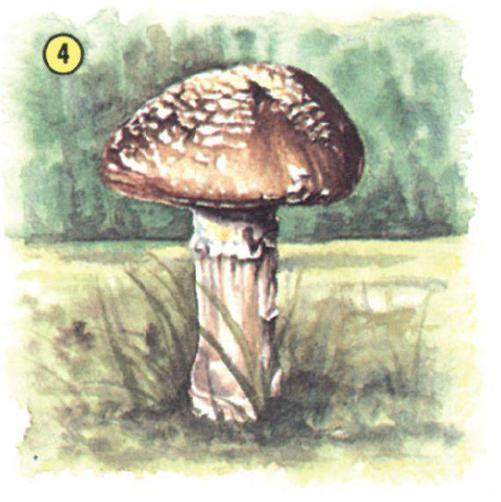
4▶Panther cap
Amanita pontherina
is common in conifer and deciduous woods, especially birch. The brown cap is spotted with white warty scales. Smells like raw potatoes. Cap diameter: 2.5-15 cm (1-6 in).
Very poisonous, can be FATAL. Symptoms: delirium, muscle spasms, coma.
5▶Deadly galerina
Galerina autumnalis
Found on decaying wood in log piles, spring-autumn. The small dark cap fades to buff. Cap diameter: 2.5-6.5 cm (1-2 1/2 in).
DEADLY. Symptoms: vomiting, diarrhoea (may not happen until after 10 hours). Kidney/liver failure may result.
6▶Deadly lawn galerina
Galerina venata
Found on lawns, often growing from buried decomposing wood. Its moist reddish-brown cap fades to buff. Tastes bitter and smells mealy. Cap diameter: 1-3.5 cm (3/8-1 3/8 in).
DEADLY.
7▶Deadly lepiota
Lepiota josserandii
Found near shrubbery and oaks. The cap has concentric bands of flattened copper-coloured scales and a musty odour. Cap diameter: 2.5-5 cm (1-2 in).
DEADLY.
8▶Deadly cort
Cortinarius gentilis
Found under conifers. Cap and stalk are a deep orange-brown. Smells of radishes. Cap diameter: 2.5-5 cm (1-2 in).
Symptoms don’t appear for 2-3 weeks after ingestion. DEADLY. Risk of kidney failure.
